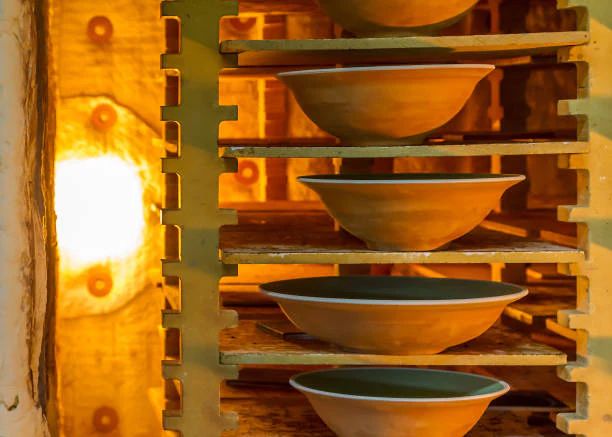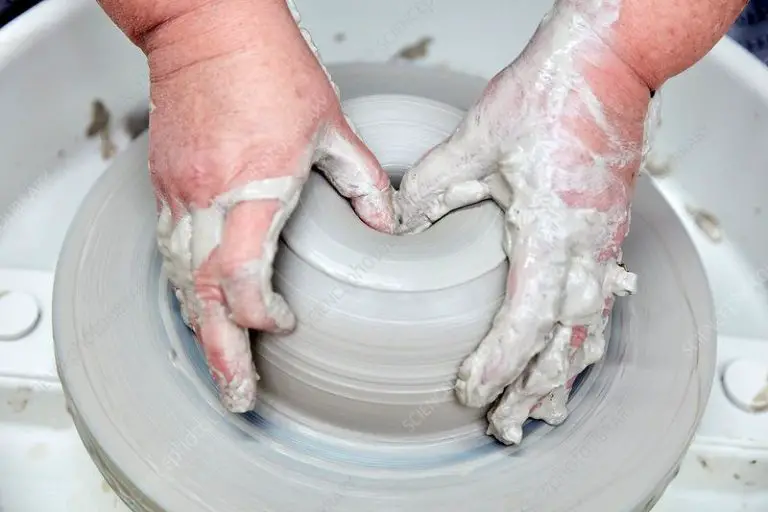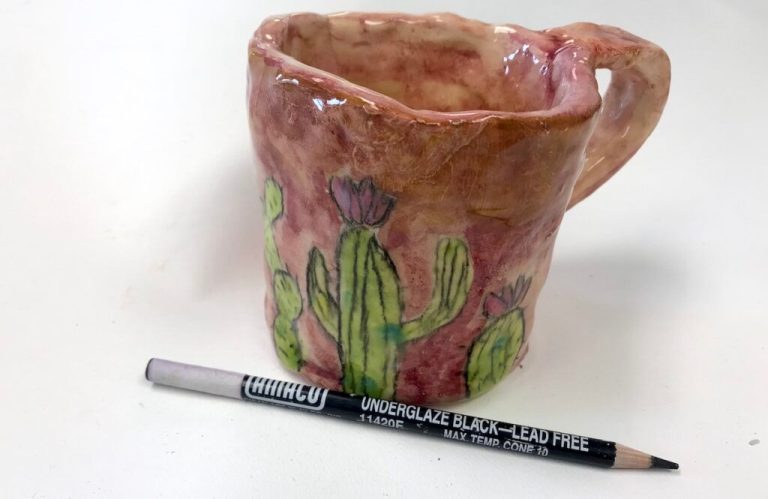Can You Use A Microwave Kiln For Pottery?
A microwave kiln is a specialized kiln designed to be heated inside a conventional microwave oven. Unlike traditional kilns that are heated by external electric elements or gas burners, a microwave kiln uses microwave energy to quickly and efficiently bring materials like glass, metal clays, and ceramics to high temperatures for fusing, sintering, or firing.
Microwave kilns offer several potential advantages over traditional kilns. They heat up much faster, often reaching fusing temperatures for glass in just a few minutes. This increased speed can save significant time compared to the hours it takes in a traditional kiln. Microwave kilns are also relatively inexpensive and small enough to fit inside a home microwave. Their small size makes them ideal for hobbyists, crafters, and small studios with limited space. Additionally, microwave kilns use less energy than most electric or gas fired kilns. Their improved energy efficiency can reduce operating costs.
While not appropriate for every application, microwave kilns enable new possibilities for small-scale artists and creators looking to fuse glass, fire ceramics, or sinter metal clay. When used properly with compatible materials, a microwave kiln can be a versatile, efficient, and affordable kiln option.
How Microwave Kilns Work
Microwave kilns heat ceramics and glass using microwave energy, rather than using conventional electric elements or gas burners. A typical microwave kiln consists of a chamber lined with insulation and a lid that contains a susceptor – a coating that absorbs microwave energy and converts it into heat (1).
When activated, the magnetron in a microwave oven generates electromagnetic waves at a frequency of 2.45 GHz. These microwaves cause polar molecules such as water to rotate back and forth rapidly, creating thermal energy through molecular friction. The susceptor material in the kiln lid absorbs the microwaves efficiently and heats up very quickly, transferring this heat to the ceramics inside the kiln (2).
As the susceptor material heats up it eventually reaches a thermal equilibrium with the ceramic pieces inside the kiln chamber. The kiln insulation helps retain the heat and allows the contents to be fired evenly. Microwave kilns can reach temperatures between 1000-1400°F, suitable for firing low-fire clay, glass fusing, enameling, decals and more.
Advantages of Microwave Kilns
Microwave kilns provide several key advantages over traditional electric kilns for certain applications:
Faster firing times – Microwave kilns can fire pieces in minutes rather than hours thanks to the rapid heating provided by microwave energy. This makes them ideal for small projects, tests, and rapid prototyping 1.
Smaller size – Microwave kilns are much more compact than traditional kilns, taking up less space in a studio or workshop. Their small interior chamber is suitable for firing smaller pieces 2.
Lower energy use – Microwaves use less electricity to generate high temperatures than traditional electric elements. This can make microwave kilns more energy efficient for certain applications 1.
Disadvantages of Microwave Kilns
While microwave kilns provide some advantages in terms of speed and low energy use, they also come with some notable downsides compared to traditional electric kilns. Some of the main disadvantages of microwave kilns include:
Less control over temperature – Microwave kilns heat glass through dielectric heating, which makes temperature control more difficult. The heating process happens very rapidly and it can be challenging to maintain an even temperature. Traditional electric kilns allow for more precise temperature regulation.
Size limitations – Microwave kilns are restricted in terms of the size of objects and volume of glass they can fire at one time. Most microwave kilns max out at around 4-6 inches tall for a single object. This makes them impractical for large-scale production or firing big pieces [1].
Uneven heating – The way microwaves interact with glass can lead to uneven heating, resulting in hot and cold spots. Microwave radiation penetrates more deeply into some areas which can cause cracking from thermal stress. Rotating pieces can help, but it’s difficult to get truly even heating.
Suitable Materials for Microwave Firing
When choosing materials to fire in a microwave kiln, it’s important to select those that are suitable for the lower temperatures achieved. Some good options include:
Porcelain – Porcelain clays are made with kaolin clay and fire to a smooth, glassy finish. They can easily withstand microwave kiln temperatures.
Stoneware – Natural stoneware clays are very durable and dense. As they vitrify at lower temperatures, they work well in microwave kilns.
Low-fire earthenware clays – These clays mature at lower temperatures, making them a good choice. Varieties like red and white earthenware are commonly used.
Specialty low-fire clays – Some clays are formulated specifically for firing in microwave kilns at low temperatures. These are very suitable options.

Low-fire glazes and underglazes – Glazes and underglazes designed for low-fire temperatures will melt and mature properly in a microwave kiln.
In general, focus on clays, glazes, underglazes, and colors rated for cone 04 or lower when selecting materials for microwave firing. Avoid any materials intended for mid-range or high-fire temperatures.
Unsuitable Materials for Microwave Firing
While microwave kilns can be very useful for firing ceramics, there are some materials that should not be used in them as they can cause issues during the firing process. Two key materials to avoid are metals and high-iron clays.
Metals are highly reflective and will spark, arc, or catch fire in the microwave. The intense heat they generate can damage the kiln walls or element, and poses a safety risk. According to Soul Ceramics, any clay work with metal inclusions should not be fired in a microwave kiln. Some glass work does incorporate metals, so this is an important consideration when selecting projects for microwave firing.
High-iron clays also present challenges for microwave kilns. As explained by Glacial Art Glass, iron bearing clays absorb microwave energy very efficiently, resulting in overheating and cracking. The high temperatures can also cause bloating. It’s recommended to select low-iron clays and glazes when working with microwave kilns.
Microwave Kiln Safety
When using a microwave kiln, it’s important to follow safety precautions to avoid injuries. Here are some tips:
Always wear heat-resistant gloves when handling the hot kiln or glass. The kiln and glass can reach extremely high temperatures that can cause severe burns (Microwave Kiln Basics and FAQs, glacialartglass.com). Use proper tongs and tools when removing items from the kiln.
Never leave a microwave kiln unattended when firing. Stay nearby to monitor the process and listen for any unusual noises that may indicate a problem (Microwave Kiln Basics and FAQs, glacialartglass.com).
Make sure the kiln is on a safe, level surface away from anything flammable. The high heat generated can damage surfaces or start fires if proper precautions aren’t taken.
Allow sufficient ventilation around the kiln to prevent overheating. Do not place the kiln inside an enclosed cabinet or block the vents.
Carefully follow the manufacturer’s instructions for proper kiln operation and firing times. Overfiring glass can cause it to crack or shatter.
Inspect glass items for cracks or defects before firing. Damaged glass can explode in the kiln.
Never put metals, aluminum foil, or other prohibited items in a microwave kiln as this can create electrical arcing and damage the kiln (Glass Fusing in a Microwave Kiln, delphiglass.com).
Allow the kiln to fully cool before handling. Use thermal gloves when removing glass items to prevent burns.
Take care when cleaning out the kiln to avoid cuts from sharp glass shards left behind.
Follow the manufacturer’s instructions for microwave kiln maintenance. Regularly inspect for any damage that could impact safe operation.
Recommended Microwave Kiln Models
When choosing a microwave kiln for pottery, it’s important to select a model that can withstand the high temperatures needed for firing ceramics. Some of the top-rated microwave kilns on the market include:
Hensom Large Microwave Kiln – This large ceramic fiber kiln has an interior size of 13.5 x 4.5 cm and can reach temperatures up to 1280°C. It’s designed specifically for glass fusing but also works for ceramic bisque and glaze firing. Reviews praise its durability and performance.
Paragon Industries F-130-3 Kiln – Paragon is a leading kiln manufacturer and their microwavable model offers a 3 cubic foot capacity that can hold multiple ceramic pieces. It has insulation on all sides and top and many ceramic artists recommend it.
Amaco Brent Microwave Kiln – This compact microwave kiln comes with a cover and is made of ceramic fiber for effective heat retention. At 1450 watts, it quickly reaches the high temperatures needed for firing pottery in a standard microwave.
These kilns allow ceramic artists to fire and finish their pottery at home safely and conveniently using an ordinary microwave. When selecting a model, look for one with enough interior space for your projects and good insulation to maintain heat.
Microwave Kiln Projects and Techniques
Microwave kilns are well-suited for small projects that don’t require extremely high temperatures. Some examples of beginner-friendly microwave kiln projects include:
– Fused glass pendants or beads – These involve stacking and fusing together pieces of dichroic or art glass. The relatively low temperatures of microwave kilns work well for fusing without distorting the glass.
– Low-fire clay pieces – Simple ceramic pieces like small bowls, mugs, or figurines can be fired in a microwave kiln using low-fire clays that mature at lower temperatures.
– Small jars or plates – Simple containers like small jars, votives, or decorative plates can be fired in a microwave kiln using the right clay body.
– Jewelry pieces – Polymer clay jewelry like pendants, beads, and earrings can be cured in a microwave kiln.
When first starting out, it’s best to choose glazes and clay bodies specifically formulated for microwave kilns. Load pieces carefully and fire according to the clay manufacturer’s instructions for best results.
Conclusion
In summary, microwave kilns can be a viable option for firing pottery and ceramic work. They provide some advantages over traditional kilns, such as faster firing times, smaller sizes, and lower energy use. With proper care and technique, high quality results can be achieved.
However, microwave kilns also come with some limitations. The size of pieces is restricted, not all clays and glazes work well, and extra safety precautions need to be taken. Firing consistency can be an issue too. For these reasons, microwave kilns may not be the right choice for all studio potters.
With research and testing, artists can determine if a microwave kiln suits their needs and style of work. For those with the patience to learn the nuances of microwave firing, it can be an accessible and eco-friendly option for turning out beautiful pottery.



